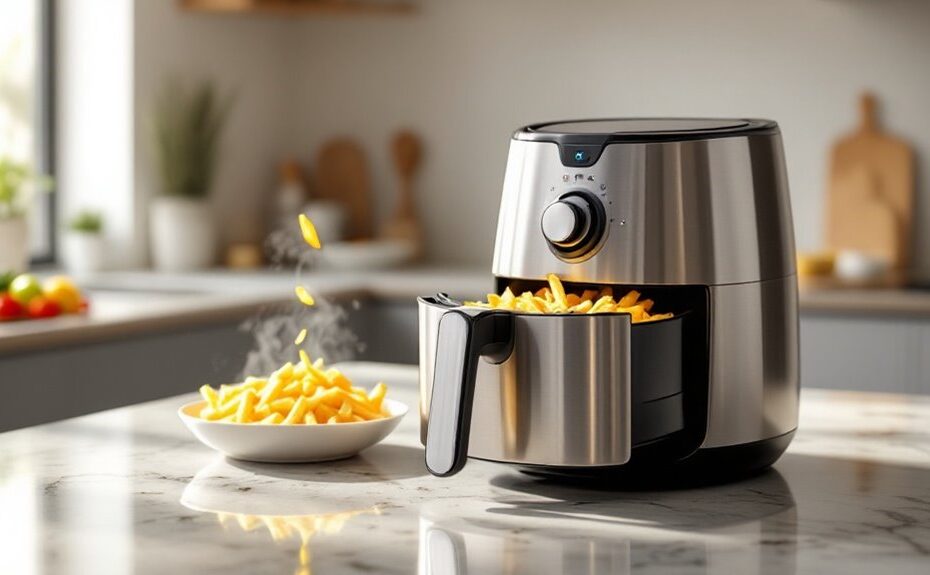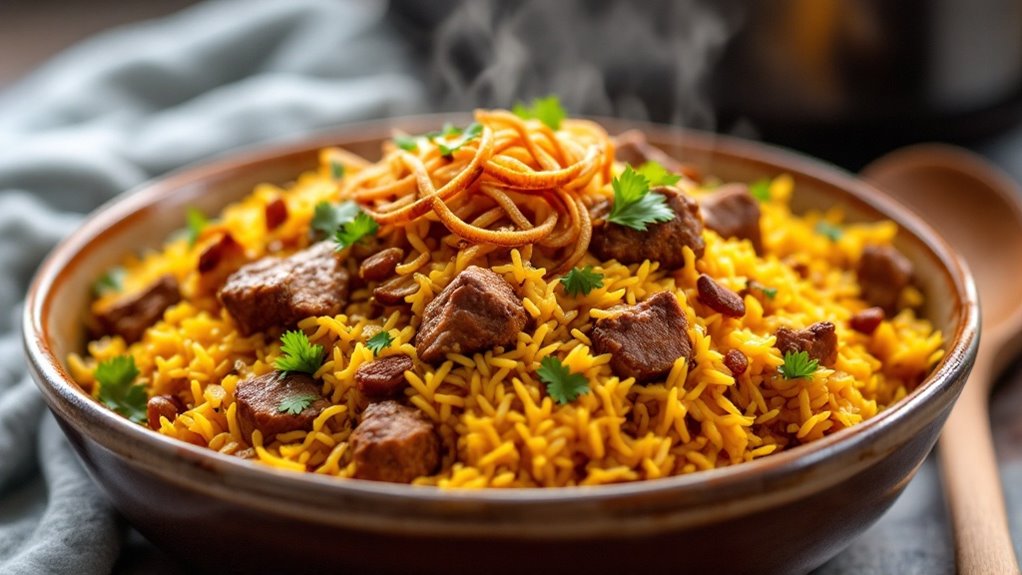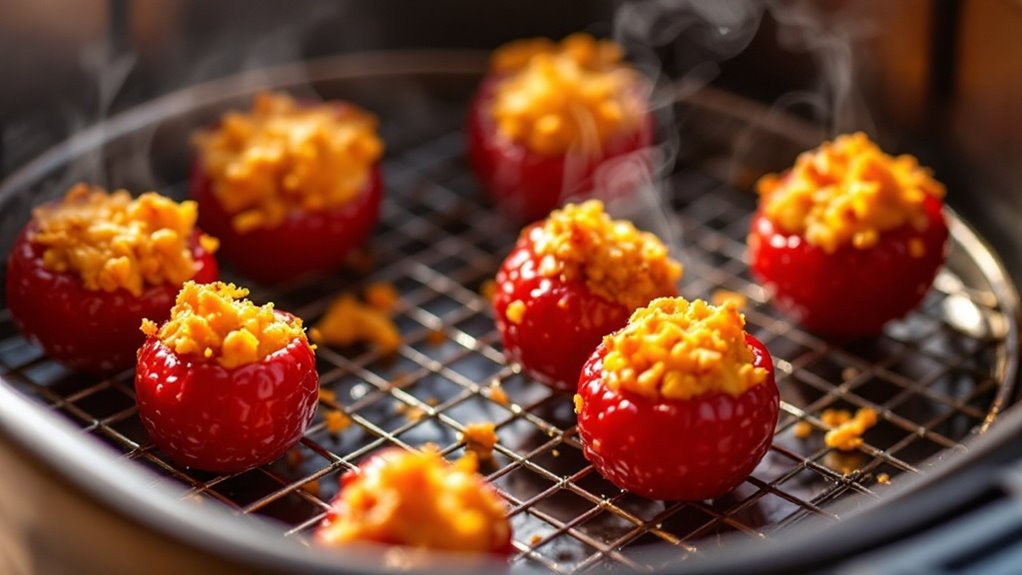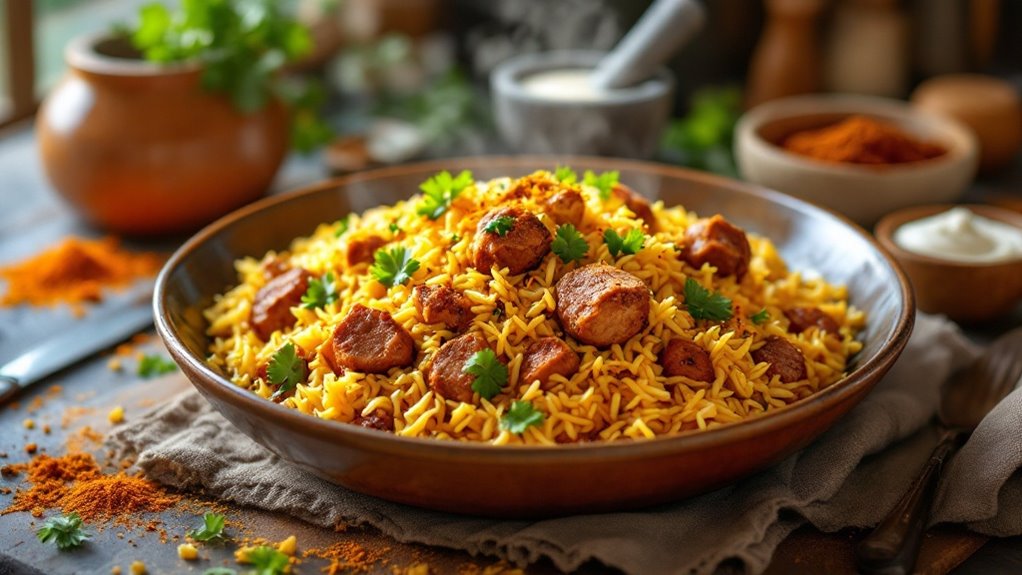Imagine a kitchen gadget that promises to shrink your guilt while expanding your culinary possibilities. Air fryers have been hailed as a healthier alternative to traditional frying, but are they truly worth the investment? You'll find they cut down on oil and cooking time, yet questions linger about their capacity and consistency. Is this appliance a game-changer for your daily meals, or just another countertop clutter? The answer might depend on how you balance convenience, health, and practicality. What you discover could reshape the way you approach cooking—or leave you wondering if it's all just hot air.
Key Takeaways
- Air fryers reduce oil usage by up to 80%, offering healthier fried food alternatives with similar crispy textures.
- They cook faster and use less energy than traditional ovens, saving time and lowering electricity bills.
- Compact and versatile, air fryers can roast, bake, grill, and reheat, but have limited capacity for larger meals.
- Ideal for health-conscious individuals and busy professionals seeking quick, easy-to-clean cooking solutions.
- Higher upfront cost and noise levels may deter infrequent cooks or those with limited kitchen space.
How Air Fryers Work
Air fryers work by circulating hot air around food at high speeds, creating a crispy outer layer similar to deep frying but with substantially less oil. Their air circulation technology relies on a powerful fan that distributes heat evenly, ensuring consistent cooking without hot spots. Unlike traditional ovens, air fryers use a rapid heating mechanism to reach high temperatures quickly, reducing preheating time. This efficiency makes them ideal for busy kitchens. Compared to deep frying, you'll use up to 80% less oil, yet achieve a similar texture. The compact design also means faster cooking times than conventional ovens, as the enclosed space maximizes heat retention. While they mimic frying, air fryers excel at roasting, baking, and reheating, offering versatility beyond just "fried" foods.
Health Benefits of Air Frying
While traditional frying methods often rely on large amounts of oil, air frying substantially reduces fat intake without sacrificing texture or flavor. By circulating hot air around your food, air fryers achieve a crispy exterior using minimal oil, resulting in meals with up to 70-80% lower fat content compared to deep frying. This reduction in oil not only cuts calories but also helps preserve nutrient retention, as excessive heat and prolonged cooking in oil can degrade vitamins and antioxidants. Air frying also minimizes the formation of harmful compounds like acrylamide, which are more prevalent in deep-fried foods. With precise temperature control, you can cook evenly while maintaining the integrity of nutrients, making air frying a healthier alternative for achieving satisfying, crispy dishes.
Comparing Air Fryers to Traditional Frying
When evaluating cooking methods, it's important to weigh the differences between air frying and traditional frying. Air fryers use rapid air circulation to cook food, requiring little to no oil, while traditional frying submerges food in hot oil. In a taste comparison, traditional frying often delivers a richer, crispier texture due to full oil immersion, whereas air frying produces a lighter, less greasy result. Cooking time difference is another key factor: air fryers typically cook faster, preheating in minutes and reducing overall cooking time compared to heating a large pot of oil. However, traditional frying may achieve a more even browning on certain foods. Both methods have their merits, but air frying offers a healthier, quicker alternative with minimal cleanup.
Energy Efficiency of Air Fryers
Because air fryers use convection heating to circulate hot air, they're generally more energy-efficient than traditional ovens or deep fryers. A power consumption analysis shows that air fryers typically use between 800 and 1,500 watts, while ovens can consume 2,000 to 5,000 watts. This lower wattage translates to reduced energy use, especially for smaller meals. Additionally, air fryers preheat faster and cook food quicker, further cutting energy consumption. An environmental impact study highlights that their efficiency reduces carbon emissions compared to conventional methods, making them a greener choice. However, their energy savings depend on usage patterns—frequent use for large batches may offset efficiency gains. For smaller households or quick meals, air fryers excel in minimizing energy waste while delivering consistent results.
Versatility in Cooking Options
Air fryers offer a wide range of cooking options, making them a versatile addition to any kitchen. You can roast, bake, grill, or even reheat leftovers, all while achieving a crispy texture without excessive oil. Compared to traditional ovens, air fryers excel in cooking speed, reducing meal prep time by up to 25%. Their compact design circulates heat efficiently, ensuring even cooking and enhancing flavor variety. You can experiment with spices, marinades, and coatings to create dishes that rival deep-fried favorites. Unlike single-purpose appliances, air fryers handle everything from vegetables to proteins, offering flexibility for diverse diets. Their ability to cook multiple food types simultaneously, without flavor transfer, makes them a practical choice for busy households seeking efficiency and culinary creativity.
Ease of Use and Cleaning
Beyond their versatility, air fryers are designed with user-friendly features that simplify both cooking and cleanup. Their intuitive controls, often featuring preset cooking modes, make it easy to achieve consistent results without guesswork. The removable basket and non-stick coating guarantee quick cleanup, as most components are dishwasher-safe. Compared to traditional frying methods, which involve messy oil disposal and scrubbing, air fryers minimize effort and time spent on maintenance. Their compact, user-friendly design also means they're easy to store and operate, even in smaller kitchens. While some models may have more complex interfaces, most prioritize simplicity, making them accessible for beginners and seasoned cooks alike. If you value efficiency and convenience, the ease of use and cleaning offered by air fryers can greatly enhance your cooking experience.
Cost of Air Fryers vs. Long-Term Savings
Air fryers typically cost between $50 and $200 upfront, but their energy-efficient design can lower your electricity bills compared to conventional ovens. You'll also save on oil costs since air fryers use considerably less oil for frying, reducing recurring expenses. Over time, these savings can offset the initial investment, making it a cost-effective kitchen appliance.
Initial Purchase Price
While air fryers often come with a higher upfront cost compared to traditional kitchen appliances, their long-term savings potential can make them a worthwhile investment. When conducting a price comparison, you'll find air fryers typically range from $50 to $300, depending on capacity, features, and brand. In contrast, basic toaster ovens or deep fryers may cost less initially, but they lack the versatility and efficiency of air fryers. A budget analysis reveals that while the initial purchase price might strain your wallet, the appliance's ability to reduce oil usage and cook faster can offset costs over time. Consider your cooking habits and frequency to determine if the higher upfront expense aligns with your needs. Investing in a quality model guarantees durability and maximizes value.
Energy Efficiency Benefits
When you compare air fryers to traditional cooking methods, they often consume substantially less energy, which can lead to noticeable savings on your utility bills. Air fryers typically use 1,200–1,500 watts, while conventional ovens can draw 2,000–5,000 watts. This energy savings comparison highlights how air fryers heat up faster and cook food more efficiently, reducing overall electricity usage. Additionally, their compact size means less energy is wasted heating unused space. From an environmental impact analysis perspective, lower energy consumption translates to a reduced carbon footprint, making air fryers a greener choice. Over time, these efficiency gains can offset the initial cost, especially if you frequently cook small meals. By prioritizing energy-efficient appliances, you'll save money and contribute to sustainability.
Reduced Oil Consumption Savings
Since air fryers rely on rapid air circulation to cook food, they require considerably less oil compared to deep frying or pan frying, which can lead to substantial long-term savings. By using just a tablespoon or less of oil per meal, you'll see significant oil cost savings over time, especially if you frequently fry foods. Traditional frying methods can consume liters of oil weekly, adding up in both expense and waste. Additionally, reduced oil usage contributes to environmental impact reduction by minimizing oil disposal and production demands. While air fryers have a higher upfront cost, their efficiency in oil consumption often offsets this within months of regular use. This makes them a practical, cost-effective choice for health-conscious and budget-savvy households.
Space Requirements in Your Kitchen
Air fryers, though compact compared to traditional ovens, still require careful consideration of your kitchen's available space. Most models demand significant countertop space, often measuring 12-16 inches in width and depth. If your kitchen lacks ample counter space, you'll need to prioritize compact storage solutions, such as tucking the appliance into cabinets when not in use. However, frequent movement can be inconvenient, especially with heavier models. Smaller air fryers, like basket-style units, are easier to store but may limit cooking capacity. Compare your kitchen layout with the appliance's dimensions before purchasing. While air fryers save space compared to bulky deep fryers or convection ovens, they still occupy more room than toasters or blenders. Assess your storage options to guarantee seamless integration into your cooking routine.
Common Air Fryer Drawbacks
While air fryers offer space-saving benefits compared to larger appliances, they aren't without their limitations. One notable drawback is their noise levels, which can be louder than traditional ovens due to the fan and heating mechanism. This may disrupt quiet environments or open-concept kitchens. Additionally, while air fryers excel at crisping, they can struggle with achieving consistent food texture across all dishes. Foods with high moisture content, like vegetables, may turn out unevenly cooked or overly dry compared to steaming or sautéing. Compared to deep frying, air-fried foods often lack the same level of richness and crunch. Understanding these limitations helps you set realistic expectations and decide if an air fryer aligns with your cooking preferences and needs.
Who Should Consider Buying an Air Fryer
If you're looking for a faster, healthier alternative to traditional frying or baking, an air fryer might be a worthwhile investment. Busy professionals will appreciate its quick cooking times and minimal cleanup, making it ideal for preparing meals during hectic schedules. Health-conscious individuals benefit from its ability to reduce oil usage by up to 80% compared to deep frying, while still achieving crispy textures. Compared to conventional ovens, air fryers preheat faster and cook food more evenly, saving time and energy. If you frequently prepare fried or baked dishes but want to cut calories or simplify your routine, an air fryer aligns with your needs. However, if you rarely cook or prefer slow-cooked meals, it may not justify the cost. Evaluate your cooking habits to determine if it fits your lifestyle.
Disclosure: As an Amazon Associate, I earn from qualifying purchases.



